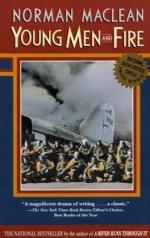
|
| Name: _________________________ | Period: ___________________ |
This test consists of 5 multiple choice questions, 5 short answer questions, and 10 short essay questions.
Multiple Choice Questions
1. Who was Arthur P. Brackebush?
(a) A former pilot of a Smokejumper's plane.
(b) A former Forest Service ranger.
(c) A former foreman for the Smokejumpers.
(d) A former student of Gisborne's.
2. After Smokejumpers are dropped on a fire, what time do they say the fire will be put out?
(a) By noon the next day.
(b) Twenty four hours after they reach the fire.
(c) Ten hours after they land.
(d) By ten o'clock the next morning.
3. How did W.R. Moore assist Maclean in his research about Mann Gulch?
(a) He ordered that all documentation on the fire be sent to the library in Missoula.
(b) He ordered that all documents on the fire be sent to Washington, D.C.
(c) He ordered that all documentation on the fire be put on the internet.
(d) He ordered that all Forest Service documents on the fire be available to Maclean.
4. When was the only time Smokejumpers were allowed to be alone while fighting a fire?
(a) As they made escape fires.
(b) As they fell to earth from the plane.
(c) As they ate a meal.
(d) As they dug trenches and holes.
5. What effect did Dodge's escape fire have on the Mann Gulch fire, according to Maclean?
(a) The escape fire made the Mann Gulch fire a blow up.
(b) The escape fire would have stopped the Mann Gulch fire.
(c) The escape fire leaves the Mann Gulch fire a mystery.
(d) The escape fire leaves the Mann Gulch fire a scientific impossibility.
Short Answer Questions
1. What emotion did Maclean believe was the last one felt by those still living when young people have died?
2. What was the name of the doctor who went in with the rescue crew the night of the fire?
3. What were the only sensations the men running from the fire were aware of?
4. What did Maclean believe the Smokejumpers had accomplished spiritually at the time of their deaths?
5. Who is one of the best bibliographical references about the Mann Gulch fire available to Laird and Maclean?
Short Essay Questions
1. How did the author describe the final moments of the men's lives before the fire overtook them? What elements of nature were prominent in their lives just before their deaths? How did they actually die?
2. What did the land in Mann Gulch look like in the aftermath of the fire?
3. What different theories did Henry Thol on one side and Carl Gustafson present as to the escape fire set by Dodge? How did Maclean suggest the Review Board of the Mann Gulch fire might have immediately answered the question of the escape fire set by Dodge?
4. When did Maclean begin research on the Mann Gulch fire? What where his first steps?
5. How did Dr. Hawkins describe the death process the Smokejumpers underwent in the final moments of their lives? To what did Maclean compare their suffering?
6. To what did the author compare the cloud of smoke atop the Mann Gulch fire when the blowup rose out of the gulch?
7. What did Sallee and Rumsey explain to Maclean that answered one of his most important questions? What was the question? What was the answer?
8. How did Maclean explain the picture of a big fire? What was it made up of in his opinion?
9. Why did both parents and the Forest Service hope for silence after the court judgments concerning suits filed against the Forest Service?
10. Who was Henry Thol, Sr.? What was his role in the Mann Gulch fire?
|
This section contains 1,397 words (approx. 5 pages at 300 words per page) |

|




